Goodeidae



Above: A poster of several kinds of goodeids to be found in Mexico.
National Commission for the Knowledge and Use of Biodiversity (CONABIO)

The name "Goodeidae family" is derived from the genus Goodea. The name of this genus is derived from the name "Goode". This genus is named after ichthyologist George Brown Goode. It's named after him by David Starr Jordan in 1880.
Goodeids are also known as "splitfins". The name "splitfin" is derived from the fact that, in the male specimen, the anterior fin rays of the anal fin are partly separated from the rest of the anal fin.
Goodeids belong to the real (true viviparous) livebearers. Unlike most embryos of Poeciliids, goodeid embryos hatch out of the egg within the ovarian follicle. For most Poeciliids will develop in an egg and when time of birth enters, the membrane of the egg will break and the newborn will be dropped out of the female's body. To the eye it seems that they are born the way mammals do.
When goodeids are born, the fry tend to be larger than with most Poeciliids. They're a mini copy of their parents and have trophotaneniae (some kind of a ribbon-like structure) at their bellies to nurture themselves for the first 1-2 days. These trophotaneniae will be shed by the fry themselves.

Below: A near term Ameca splendens embryo with appending trophotaeniae (photo by Joachim F. Schindler, Structure and function of placental exchange surfaces in goodeid fishes).

Another difference with most Poeciliids is that the males don't have a gonopodium but an andropodium. The andropodium is a notch on the front of the anal fin. The picture below shows the andropodium.

And unlike most Poeciliids, each pregnancy should be engaged by a new copulation. Most Poeciliid females can store sperm which enables one copulation to accomplish multiple pregnancies. But goodeid females can't...
The larger part of all Goodeids are endemic to shallow waters (fresh and brackish water) in Mexico and some in The United States. Depending on the strain, these livebearers can withstand low temperatures pretty well. Another note that someone should take notice when starting to keep goodeids is that most of them aren't really adaptable to a community tank. The majority of these goodeids can be dominant in their behavior and most of them are real fin nippers. They won't nip fins of other goodeids what I've noticed out of experience. Best is to keep most goodeids in a species tank.
Not all goodeids but a reasonable number like to shoal from time to time. So, shoaling is not a general thing goodeids will do.
With all goodeids I'm keeping and have kept, I've noticed that they do well in an environment with a still water surface.
Ameca Splendens
This species is also called butterfly splitfin. The species is endemic to Jalisco in Mexico. A beautiful marbled fish but not suitable for a community tank. They tend to be aggressive to other tank members and real fin nippers indeed. or keep them in a larger sized tank with other breeds of well-sized fish which have a certain dominance in their genes as well.

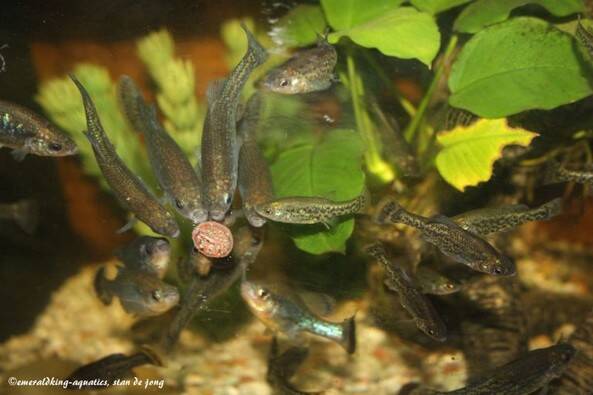
They're also good algae eaters. It's a diet which they do appreciate. So, in case a lot of algae growth is at hand, these are the fish to keep. The picture above shows some algae growth on the glass. Those A.splendens are just happy with it.
Goodeids in general can be kept outside during spring and fall season. They're easy breeders ( 5 till 20 fry each drop) but it's also a fact that they will reproduce themselves outdoors far more easier than when they're kept indoors.
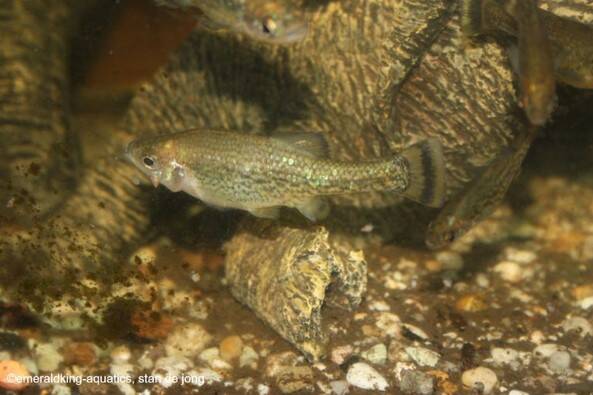

Above: An adult male (photo left) and an adult female (photo right).
It's a hardy fish and they'll do also well in a less clean kept environment. A male wil reach up to approx. 8cm and a female up to approx. 12cm. A suitable temperature rate can be kept moderate between 20°C - 25°C.

But despite of the fact that the Ameca splendens likes temps above 20°C, they can withstand much lower temps as well for they are inhabitant to colder endemic regions in Mexico. I've even harvested them from my outdoor tank during fall at rates of 8°C water temperature at day.
Xenotoca eisini, San Marcos
Note: This species is called "Xenotoca doadrioi" ever since the year 2016. But I'm using the old scientific name which I'm used to all these years.
This species is also known as the red tailed goodeid and as the red tail splitfin.
The San Marcos redtail splitfin is endemic to the Mexican federal state of Jalisco. It was historically known from springs (e.g. Almoloya, San Sebastián) and dams of the endorheic Laguna de Magdalena basin including the lagoon itself, from headwaters of the Rio Chiquita near the town of San Marcos (Arroyo lezontete headwaters), including the Presa Limoncito (Oconahua dam), a Rio Ameca affluent, and probably from the Rio Salado, a Rio Ameca affluent about 15km west of Guadalajara. A population of this species in Granja Sahuaripa in Mexico has disappeared back in 2006. And in 2015, this location turned out to be mostly completely dry by natural causes. But the Pseudoxiphophorus bimaculatus (which has been introduced by man) is still living on that location.
A livebearer mainly found in Mexico and tolerate rates of 15°C - 27°C water temperature. But preferable to keep them between 18°C - 22°C. With its size one of the moderate sized livebearers. Male will reach 6,5cm and females 7,5cm in length.


These fish are (as all members of the Goodeidae genus) considered being the real livebearers unlike most Poeciliids we know. The size of the newborn fry can differ a bit. despite of the fact that they can be large offspring, their size can be reduced if a batch is large. For most of the time they will drop between 10 - 20 fry.
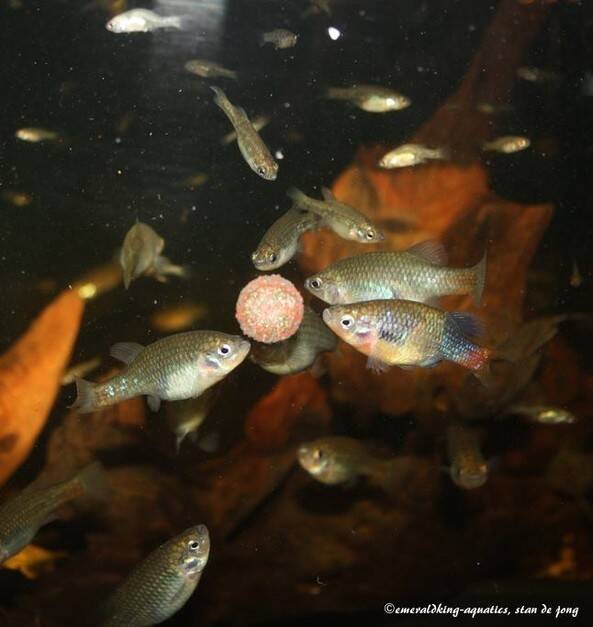
This livebearer is considered being aggressive and should be kept in a species tank. For also this is a real fin nipper... I've kept these guys in one of the outdoor tanks and they did really well during springtime till fall. Also the reproduction outdoors is phenomenal.
Zoogoneticus tequila
This goodeid is also called "Tequila splitfin" and "Picote tequila".
This species is to be found in Rio Teuchitlán of the Rio Ameca drainage from the Pacific Slope in Jalisco, Mexico.


It's one of the more impressive goodeids there are to me. There's a difference in coloration between both genders. The male is dark olivaceous on both sides with some greenish and blue on both sides. a reasonable number of scales are reflective, iridescent as a result. The caudal fin has a broad reddish till orange band. The females however, seem more pale in comparison to the male. And mostly with somewhat larger females, a broad band of light orange appears as well in the caudal fin as the pictures below show.


A gestation of this breed will take about 7 - 9 weeks before an average brood of 10 - 15 fry will be born. They'll size up to approx. 6 - 8cm.
Best kept at water temperatures between 18°C - 22°C during the better months of the year. It's preferable to keep them between 15°C - 18°C during the winter season to give them a period of rest and it's better to their health to establish this fluctuation.
Is this a suitable fish for a community tank? Well, that really depends on the nature of each individual fish. They can be very peaceful but they can be very territorial as well. And they don't always harmonize with other goodeid breeds as well.
Zoogoneticus Purhepechus
This goodeid is also known as La Luz splitfin or Tarascan splifin. The name "Purhepechus" is derived from the name "Purhepecha". The purhepecha is an ancient local Indian tribe which still exists.


This species knows a wide distribution range from the Lower Rio Lerma drainage (including its affluents), Laguna Chapala, adjacent areas of the Rio Grande de Santiago ( including its affluents) until it almost hits Guadalajara (capital city of the state of Jalisco). And this species occurs in the endorheic lagoons west of Lake Chapala.
It's a peaceful goodeid which prefers slow till moderate flowing waters, like a lot of other goodeids prefer as well. And also these goodeids are best kept at moderate temperatures.
Below: This is a species that loves to shoal on a regular bases.

The difference between both genders is quite easy. Females become a bit bigger in comparison to males. And the males develop a red coloration on the edges of the dorsal, caudal and anal fin (individually, also on the pelvic fins). And of course, males do have an andropodium. The shape of the dorsal is quite similar with both sexes.
In general they'll have an average adult size of 4-6 cm.

Above: Male (left) a female.(right).
This species is officially a carnivore but does accept plant material as well.
Ilyodon xantusi
A more slender goodeid is the Ilyodon xantusi also known as "Limones splitfin". This goodeid species is nowadays also known as "Ilyodon furcidens".
This Mexican livebearer is to be found in teh state of Colima in the Rio Colima, Haciendo Los Limones, 2 km southwest of Villa Alvarez. But also in the states of Michoacán and the state of Jalisco. Where they inhabit rivers like Ameca, Ameria, Tamazula, Chituatlán and Coahuayana. They inhabit fast moving waters where they'll swim fast through with their streamlined body. So, be sure when you'll keep them, that they're housed in a wide sized tank.

It's an easy to keep goodeid species which has also a friendly nature. What's so typical about the reproduction is that the number of fry with each batch does differ a lot with same sized females. So wether that's 10 or 40 fry each batch is hard to predict. Despite of the fact that also fry of this kind are large in size at birth, fry will be less large sized when the number of fry is large. They also leave their offspring at peace. So, hardly fry will be eaten by the adults


There are specimens which have yellow edged fins but also specimens with more translucent fins with a speckled pattern on them. The speckled pattern on mostly the lower part of the body are leopard-like spots.
They do well in a wide range of water temperature. Even muddy water doesn't seem to harm them. A good option is to keep this strain outdoors during spring till mid fall where they can size up to a decent size.
Ataeniobius toweri
The Ataeniobius toweri also known as "Striped goodeid" or even "Bluetail goodea" is a very slender goodeid.
This strain is endemic to Laguna Media Luna, a drainage of the Rio Verde in Mexico.


Also this goodeid doesn't really have the obnoxious characteristic of fin nipping which makes this kind suitable in a community tank. It will grow up midsized (approx. 5-6 cm). Males tend to develop a blue shimmer on their fins.


Above: A bag full of juveniles (photo left).
Young fish do show 1-3 stripes on the side which seems to disappear when hitting adulthood. But when light hits the sides of the fish, you definitely will still see those stripes. Young fish also look more gray-bluish of color.
Unlike most goodeids this strain does prefer higher temperatures. But I do have to admit that they do well as well at lower rates. I myself keep them at approximately 18-22°C. So, despite of their endemic location where it's warmer than where most goodeids are to be found, they do adapt quite easily to lower rates.
Well, it's just a personal preference wether one would call this an interesting fish to keep. It doesn't show too much brightness in color but to me it's the fish itself that interests me. They're more vivid when kept in a group. But a small number of these fish will do fine as well in a tank. So, no pressure to purchase a whole bunch of them.
Characodon lateralis
This goodeid is also known as "Rainbow characodon".
It inhabits a series of small localities below the waterfall (El Saltito) in the upper Rio Mezquital basin,Durango state, central Mexico. And the localities where they are to be found are Los Berros, La Constancia, Amado Nervo, San Juan and last but not least Nombre de Díos.
I myself am keeping fish of Ojo de Agua Los Berros (2005).

The breed I've got are olive-brown bodies and males tend to have more coloration than females do. Both genders have a lateral stripe on both sides (plural blotches on a row) which hardly reaches the caudal peduncle. On the belly they're white till gray. Most of the Los Berros Ch.lateralis do show some red in their fins and on their body when they've reached adulthood. But there's also a number that will turn green instead of red at adulthood.


They tend to grow slowly and they'll size up to 4 - 6cm.
Despite of the fact that this strain is considered being territorial, I do keep them together with endlers. Which seems to be a good combination.

Also this breed has got a long gestation with an average of 7- 9 weeks and afterwards an average number of 5 - 20 fry will be born.
Neotoca bilineata
This goodeid is also known as "Two line skiffia" and "Tiro de dos rayas".
This species originates from the Pacific Slopes and inhabits the Rios Lerma-Grande de Santiago basin and the endorheic Rio Grande de Morelia basin in the States of Jalisco, Michoacán and Guanajuato.

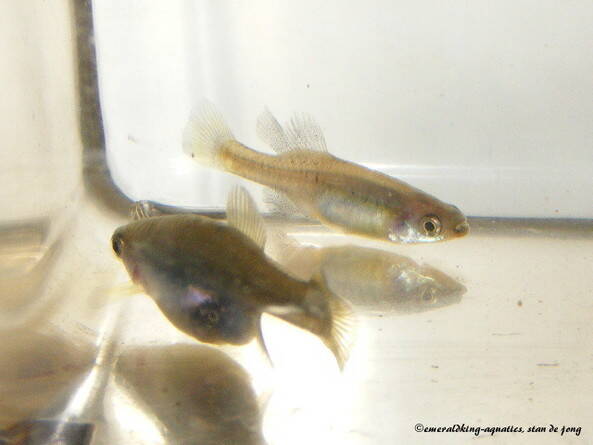
They prefer slow running water. Furthermore, they're really adaptable to a wide range of temperatures. The only problem that occurs when held at higher temps is that they won't outgrow that much. Reproduction at higher and lower temps doesn't seem to be of any influence. Even at rates of 8°C - 12°C won't stop them from breeding.
Both genders are almost equally colored. But an adult male will develop a dark colored dorsal fin and anal fin. The caudal fin however won't get so dark.

Above: An adult male (left) and an adult female (right).
Girardinichthys vivipares
Another smaller goodeid which seems very peaceful is the Girardinichthys vivipares also known as Chapultepec splitfin.
This small goodeid is mainly to be found in almost still and shallow waters of the endorheic basin of Valle de México (Valley of Mexico). According to literature this species was also found in other areas (by natural influences or by man seems not clear).


They color will range from grayish till a bit sand colored and somewhat speckled pattern on the scales. Also the edges of the fins is a bit darkened. Males tend to have a bit darker coloration in comparison to females. And during courtship males can become darker for that matter.
But also dominant males can become very dark till real black. A good example is shown in the following the photo left above. It's a dominant (alpha) male and the male in the back shows a beta male. But the beta male does show ferm dark edges on its fins. In the next picture an adult male which shows his dark edged fins.


To keep them well they need to be kept at lower temperatures. Long term higher temperature exposing won't do them any good. For they will live much shorter than the expected lifespan. They do also well in muddy till very clear water. So, that's a lucky break for someone who's lacking a good maintenance quality. But I'm not encouraging low maintenance with these fish by any means to be honest. In some way, it also takes a bit longer before this strain comes to adulthood.
Below: Two adult females.


This is such a friendly goodeid which doesn't nip at other fish's fins. It's very suitable to be kept with other friendly fish which can be kept at lower temperatures. In case you wonder what their favorite food might be... it's algae!
Chapalichthys pardalis
This goodeid is also called "Polkadot goodeid" and "Leopard goodeid". The name "Chapalichthys" refers to the Chapal lagoon. The Chapal lagoon is the largest natural lake of Mexico. The name "Pardalis" is derived from the latin word "Pardus". And "Pardus" is derived from the greek word "Párdos" which means "the mottled one" or "panther" or "leopard". The adjective "Pardalis" however means "mottled or colored one like a panther".
The fish itself is endemic to the waters of the pacific slope of Mexico, federal state of Michoacán, Tocumbo district.
The name "Chappalichthys pardalis" is considered by many to be the exact same species as the ""Chapalichthys peracticus". But there are also people who believe that they're in the same genus but separate species. But, if you wanna be sure you've got the right species, keep these two separate from eachother.


These goodeids do well at lower temperatures till moderate. And they prefer to swim in still water till moderate water flows. But despite of this preference, they'll do well in faster water flows as well.

Left: A better view on the high dorsal of the male.
Right: A very pregnant female.

This species is considered being a herbivore but it will eat insects as well. I've even given them dried shrimps without a problem.
The differences between male and female specimens is the andropodium of the male and the higher dorsal of the male. In general the male does have a yellowish colored band at the end of the caudal fin. But I've noticed that also female specimens can develop this coloration. But an adult male will also show a higher back in comparison to a female.
Below: Two adult males.

Both male and female can size up till max 8,5 cm of length. But in an average fish tank most will size up till 6 cm.
Alloophorus robustus
The Alloophorus robustus is also known as the Bulldog goodeid. The name refers to the strong appearance and strong jaws of this species.
This species has a large distribution range and have been found in the Mexican Plateau in west-central Mexico, such as the Rio Lerma basin and the northwest tributaries of Rio Balsas in the states of Guanajuato, Jalisco and Michoacán. The character of the waters where they occur are still waters till slow running waters.

Above: The most right fish is a female and the other two specimens are males. The shape of the dorsal already tells us the gender of the fish.
They're real carnivores. They're even the most developed carnivore species within the goodeid family. They mainly feed themselves with other fish and insects. But I do have to note that I have mine get used to flake foods and greens as well. And it seems that they don't have any problems with that. But again, they're actually carnivores. They can swallow a fish a ¾ of their own size without a problem. This doesn't make this species the perfect company in a community tank. Unless, the other specimens are from a larger and aggressive species as well. But don't be surprised if they'll start a fight with another aggressive species of their own size or even bigger. This species is a predator by all means...! But if one would choose to have some smaller fish as tankmates, I'd suggest to choose bottom fish like corydoras or ancistrus. In some way, these bulldog goodeids will leave such fish alone.


Above: A dominant male (photo left).
These fish will size up till 15-18 cm if the conditions are available. In an average tank they'll reach up to 10 - 15 cm. And a male will stay a bit smaller than a female.
Further differences between the two sexes is minimal. Of course, the male's got an andropodium. The dorsal of a male is higher and so is the back in comparison to the female. Body color is identic with the exception of a dominant male. A dominant will be come darker than the other males.
Be sure to keep them at lower till moderate water temperatures. Higher rates will make them sick and they may die when kept at constant higher temperatures.
Allodontichthys tamazulae
Allodontichthys tamazulae is also known as "Tuxpán splitfin" or "Peppered splitfin".
This stretched shaped goodeid species is widely spread throughout the Tuxpán River system in the federal state of Jalisco, Mexico.

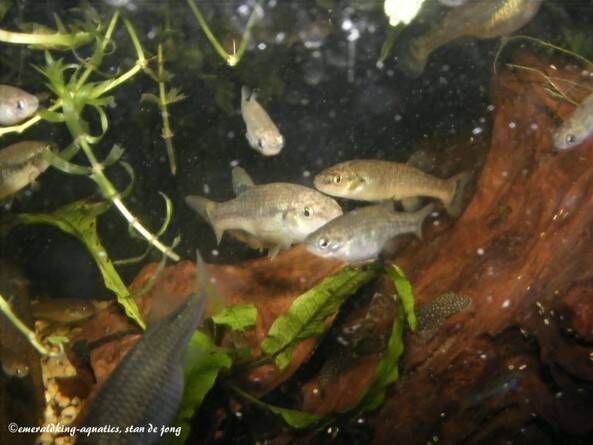
There's really not much difference between both sexes with the exception of the obvious andropodium of the male. Further differences are the dorsal shape. males have a somewhat broader dorsal and the black blotch is more present in the dorsal in comparison to the dorsal of a female. But from a distance, it's not that easy to determine the gender.


Above: An adult male (photo left) and an adult female (photo right).
In general they'll size up to 6 - 8 cm and both sexes will be equally in size. Further o,n should they be kept at lower till moderate temperatures and slow flowing water. Higher temperatures can be fatal to these fish.
A SPECIAL NOTE: These are excellent jumpers in comparison to other goodeids. The tank they will be kept in should be covered
Skiffia multipunctata
The Skiffia multipunctata is also known as "Splotched Skiffia" or "Spotted Skiffia".
This species occurs in the Lower Rio Lerma throughout the federal state of Jalisco and Michoacán, Mexico. Populations in the area of the Rio Duero dam and Guadalajara seem to be extinct.

It's quite a peaceful goodeid and well suited for a community tank. But of course, a species tank would be preferable. They can tolerate water temperature from 15°C - 24°C. It's preferable to give them a period of rest during the winter season at lower temperatures (preferably beneath 20°C).
If we look at the pattern of each individual specimen, we do see a complete variety of black blotches no matter the gender. The name "Multipunctata" does refer to these blotches.
Below: Overhere an almost full black adult male which seems very popular amongst keepers of these fish (photo left).


Above: A black adult male. But also females can have big black blotches on their body but it concerns mostly males.
Above: An adult male with less blotches.
Below: An almost adult spotless female. .
Below: An adult female with blotches
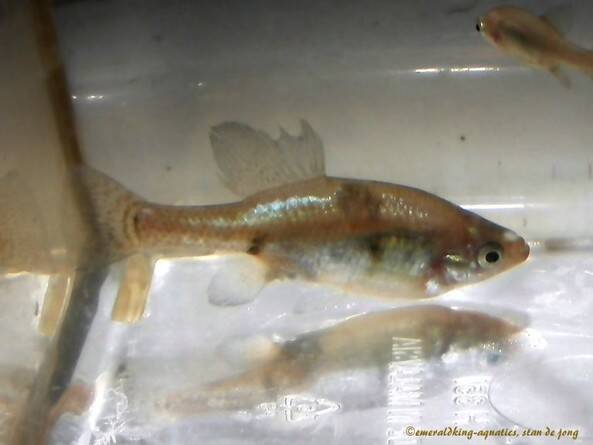

Their tolerance in water temperature was already mentioned. But if you'd like to keep them at a steady temperature, it's better to when these goodeids are best kept at lower till moderate temperatures than higher temperatures and a low water current.
Further on, these goodeids will size up till 5 - 7 cm.
Xenotoca variata, Jesus Maria
The jeweled splitfin (Xenotoca variata or in spanish "Pintada") has got his from its looks. For each specimen differ in coloration and pattern. The one thing do have in common is the glitter look when light hits the scales. This species is to be found in the Mexican federal states of San Luis Potosí, Jalisco, Aguascalientes, Michoacán, Guanajuato, Querétaro and Zacatecas. The ones I've acquired came from a location nearby Jesus Maria (a town in the state of Jalisco).

They inhabit mostly shallow and moderate flowing till still waters. The areas have mostly muddy till rocky substrates with lots of vegetation and rich of algae. For also this goodeid loves to eat algae. But it's a real omnivore. So, also live food will be eaten by them.


It's a goodeid that is able to reach 8-9 cm but in captive bred specimens will stay a bit smaller. Aggression amongst members of the same group doesn't occur so often from what I've experienced. But they can chase eachother to see what the pecking order is. But no fish will be harmed during the chase. But they're not quite suitable to be kept with friendly species. So, it would be advisable to keep them in a species tank or combine them with some cichlids, loaches or catfish.
This species does extremely well when kept outdoors during the better months of the year. They'll withstand temperatures of 12-15°C perfectly. They will reproduce quite easy when they're kept at rates between 19-24°C. Lower or higher than this margin, they'll gradually stop reproducing. When a male is ready to mate, he'll darken his body for a while. This is something that can happen as well with other kinds of goodeids.

Above: This is an adult male and ready to mate. Look how he's darkened his body.

